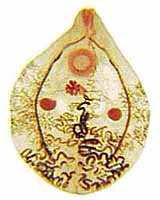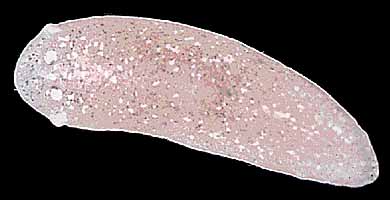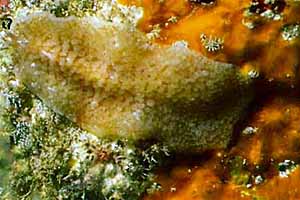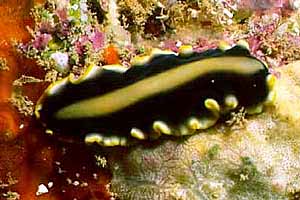 |
 |
The simplest animals that are bilaterally symmetrical and triploblastic (composed of three fundamental cell layers) are the Platyhelminthes, the flatworms. Flatworms have no body cavity other than the gut (and the smallest free-living forms may even lack that!) and lack an anus; the same pharyngeal opening both takes in food and expels waste. Because of the lack of any other body cavity, in larger flatworms the gut is often very highly branched in order to transport food to all parts of the body. The lack of a cavity also constrains flatworms to be flat; they must respire by diffusion, and no cell can be too far from the outside, making a flattened shape necessary.
 |
 |
Life without a coelom : The image at left is a fluke (possibly a species of Probolitrema). Flukes, like other parasitic flatworms, have complex life cycles often involving two or more host organisms. At right, a planarian (Dugesia). Planarians are free-living flatworms, and have a much simpler life history. They inhabit freshwater, and are carnivores (even without teeth) or scavengers. Most are less than a centimeter long. (Click on either of the pictures above for a larger image).
Flatworms were once divided into three groups. The mostly free-living Turbellaria include the planarian, Dugesia, shown above; these are found in the oceans, in fresh water, and in moist terrestrial habitats, and a few are parasitic. The Trematoda, or flukes, are all parasitic, and have complex life cycles specialized for parasitism in animal tissues. Members of one major taxon of flukes, the Digenea -- which includes the human lung fluke depicted at right -- pass through a number of juvenile stages that are parasitic in one, two, or more intermediate hosts before reaching adulthood, at which time they parasitize a definitive host. The Cestoda, or tapeworms, are intestinal parasites in vertebrates, and they also show anatomical and life history modifications for parasitism.
It now seems likely that the first two of these groups are paraphyletic; that is, they contain some but not all descendants of a common ancestor. Recent molecular studies suggest that the Platyhelminthes as a whole may even be polyphyletic, having arisen as two independent groups from different ancestral groups. If this latter view is correct, then most of the flatworms may belong to the Lophotrochozoa, a large group within the animal kingdom that includes molluscs and earthworms, while the rest belong near the base of animal diversity.
 |
 |
Marine flatworms : The marine flatworms (polycladids) are the largest of the free-living flatworms, sometimes reaching lengths of 15 centimeters. Polycladids get their name from their highly branched digestive cavity. These individuals were photographed on a reef near the island of Guam. (Click on either of the pictures above for a larger image).
Platyhelminths have practically no fossil record. A few trace fossils have been reported that were probably made by platyhelminths (Alessandrello et al., 1988), and fossil trematode eggs have been found in Egyptian mummies and in the dried dung of Pleistocene ground sloth. Trematode larvae that parasitize molluscs may leave pits or thin spots on the inside of the shell, and these pits may be recognized on fossil shells. If the mollusc is irritated by the presence of trematode larvae, it may be able to surround them with layers of shelly material - and thus do parasites become natural pearls.
Images of a number of free-living and parasitic flatworms, from Rudolph Leuckart's 19th century zoological wall charts, are available (look for "Platodes" in the index). More detailed classification of platyhelminths is available from the Tree of Life at the University of Arizona.
To find out more about tapeworms and flukes that cause human disease, read this handbook published by the U.S. Food and Drug Administration, view these pages produced by the World Health Organization. The disease schistosomiasis, or bilharzia, is a serious health problem in many parts of the world; you can learn more about it from the World Health Organization.

Sources:

